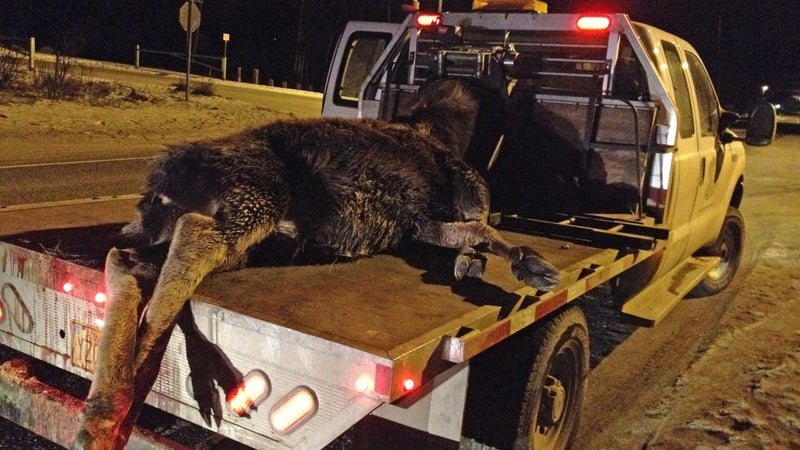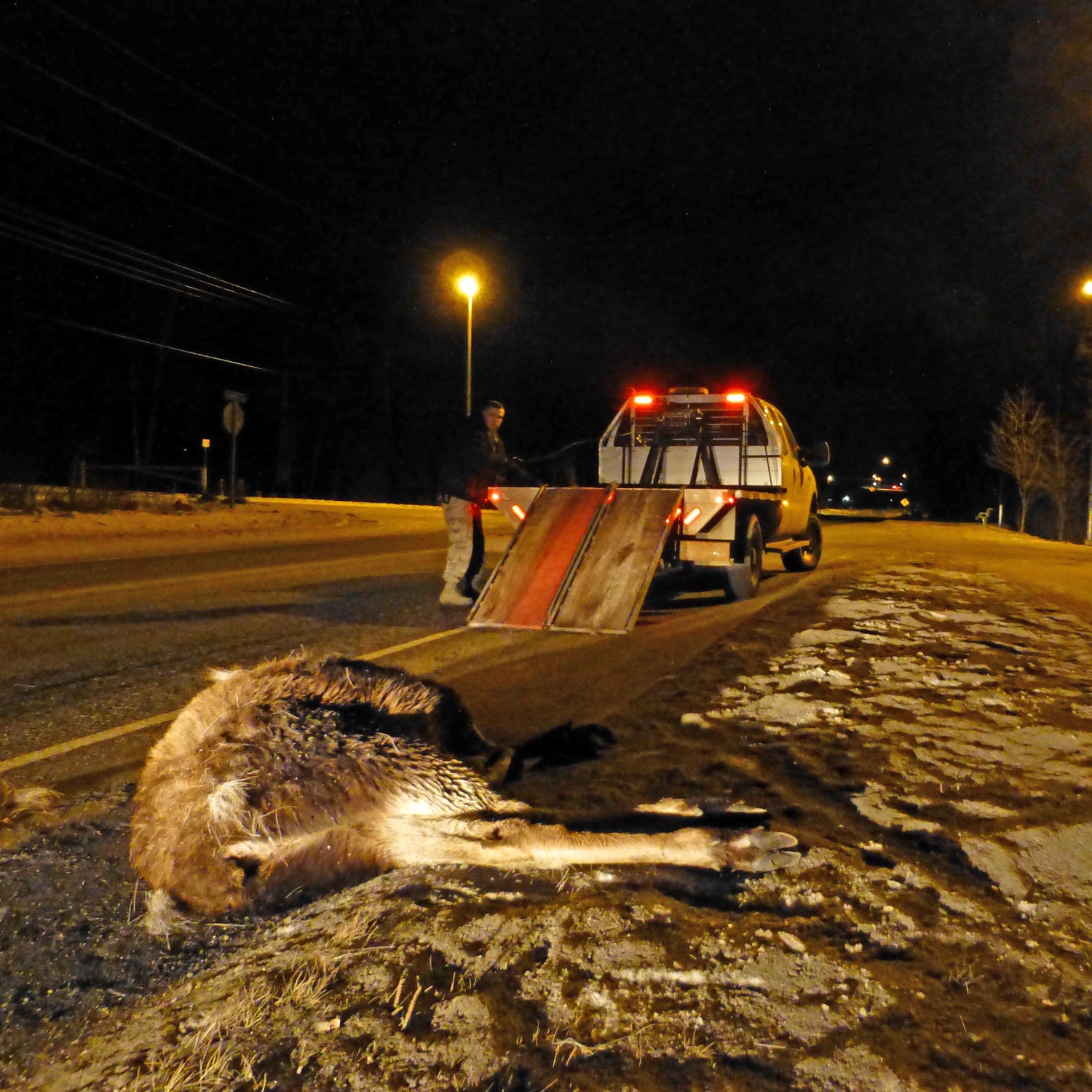ÔÇťI want you to get back in your car and wait there.” The voice coming through my cell phone belonged to Don Dyer, executive director of the , which recovers the bodies of roadkill moose and distributes them to individuals and charities that can make use of the meat. I'd already gotten back into my car, having spotted the mother of a dead calf advancing toward┬áme. Every long-time Alaskan knows that when a cow moose approaches you looking intentÔÇöhead down and the hair along her spine raised in agitationÔÇöit's time to beat a hasty retreat.
It was a Thursday in early February, a little after 5 a.m., completely dark. I was parked on a neighborhood side street in Anchorage, near the body of a moose calf that had recently been hit by a car. For more than a month I'd been trying to coordinate a chance to see one of Dyer's drivers in action, winching a dead moose off the road and delivering it to the next name on a “roadkill list” maintained by the Alaska State Troopers. Anybody can get on the listÔÇôitÔÇÖs mainly individual citizens and a few non-profitsÔÇöas long as you're willing to accept and butcher a fresh moose corpse at a moment's notice.
There are an estimated 175,000 to 200,000 moose in Alaska. The animals are a constant presenceÔÇöeven in urban areasÔÇöand they get hit by cars all the time, usually around dawn and dusk, when both the animals and commuters are most active. From July 2011 to June 2012, the most recent year for which the Alaska Department of Transportation has hard data, nearly 800 moose were hit by cars around the state. Car-moose collisions can happen literally anywhere, even in the heart of the state's only large city, Anchorage, but they're most common where brushy habitat meets water sources along high-speed highways. Only about one quarter of one percent are fatal for the people involved. Occasionally a moose will walk away too, but most of the time it either dies on the spot or has to be put down by first responders.
Then what? There are a thousand pounds of mammal on the roadway, blocking traffic and attracting scavengers like bears.
Until about six months ago, you were likely to see a civilian butchering that moose on the side of the roadÔÇösometimes in the road. ThatÔÇÖs where the moose federation comes in. Since 2008, the federation has helped in a limited capacity, dispatching drivers in flatbed pickups with winches to quickly remove whole moose carcasses from roadways and deliver them to the next names on the list for butchering. But in late August of 2015 the federation was awarded a $300,000 contract for handling roadkill salvage in four population centers: Anchorage, the Mat-Su Valley, the Kenai Peninsula, and Fairbanks. For the first time ever, there's a single entity responsible for collecting the bulk of the roadkill moose on the contiguous road system.
But Dyer estimates that, depending on how much snow we get, the federationÔÇÖs funding will only stretch to cover one more winter. The deeper the snow, the more likely moose are to wander the roadways, where travel is easier but dangerous. If Dyer can't find another source of income, the state will have to find another solution. The most likely option is a return to the old days of volunteer salvageÔÇöresidents butchering dead animals on the roadsides.
On the morning I waited in my car for the agitated mother moose to move on, I got out of my car to approach her calf's dead body. It lay draped over the edge of a curb, across a bike lane, sporadically illuminated by the swirling lights of a police car that had arrived on the scene. The officer didn't know what had hit it but, judging by a couple of broken legs and relatively little damage to the body, it was probably a small car. 
Recipients have sobbed with relief. They'd been down to the very last bit of food until the moose carcass arrived.
Phillip Sneed, a young Air Force policeman from nearby Joint Base Elmendorf-Richardson made quick work of recovering the calfÔÇÖs body when he arrived in his flatbed pickup truck.┬áHe secured the winch cable around the calf's head, hooked a detachable ramp onto the edge of the bed, and up the body went.
Volunteers like Sneed track down animals that sometimes stagger into the woods to die after the collision, wrangle the bodies onto trucks, dodge fast-moving traffic and angry mother moose when a calf is involved, and deal with curious bystandersÔÇöat all hours of day and night. But the reward is worth it.┬á“The thing that really motivates the volunteers is delivering food to people, and how excited the people are when we show up with a moose,” Dyer says.
It's hard to quantify the impact that receiving a moose carcass can have on a family. But in a state where roughly one in seven people are deemed “food insecure” and the number of families struggling to make it from month to month is continuously on the rise, the 350 or so pounds of meat you'd get from a good-size cow can make a huge difference. Dyer told me that over the last six months, two recipients have thrown their arms around his drivers and sobbed with relief, explaining that they'd been down to the very last bit of food in the house until the moose carcass arrived.
Usually, Dyer and Sneed told me, when you pull up to a house or business, you're met by a small army of volunteers that are ready to go to work on the moose. It's like a party. But that day's recipient, 64-year-old Roger Monson, met us alone outside his Anchorage home with a tarp spread over an empty spot in his driveway. He'd been waiting a year and a half for a roadkill moose, and he looked pleased. “I'll butcher him a little different than my dad taught me,” Monson said thoughtfully, looking down at the calf.
When I called Monson back later that day, I caught him and a friend taking a break from the butchering. “We got her all cut up,” he said. “All the ribs on one side were broke, but most all the meat is good.” A good-size calf like that easily yields more than a hundred pounds of usable meat. Monson estimated that would be enough to feed him, his butchering partner, and their wives for the year.┬á
Hitting a moose is terrifying, and as anyone who lives in deer country knows, there's only so much we can do to avoid these giant, unpredictable deer that are prone to popping up seemingly out of nowhere. Every expert I talked toÔÇöfrom Dyer at the federation to the Alaska Department of Transportation and biologists with the state Department of Fish and GameÔÇôsays that speed is the biggest risk factor when it comes to hitting a moose: the faster you're going, the less time you have to react when a moose suddenly darts into the road, and the more serious the consequences are for both of you when you hit.┬á
Location and timing exacerbate the problem. Many of Alaska's high-speed roads have little or no lighting and run through prime moose habitat. Add in the fact that moose tend to be most active during the morning and evening commutes, and you have a problem. “Depending on the size of the moose and the size of the vehicle, you basically take the legs out…and then the body of the moose goes right through the windshield,” says Lex Patten, an Anchorage firefighter that has responded to fatality and injury calls involving moose-car collisions.┬á

Patten has one of the most spectacular moose-versus-car stories in existence. He was driving his GMC pickup into Anchorage on the Seward Highway in early February. Going up a dark hill at about 60 mph, he spotted three cars parked on the right shoulder, one of them with its back-up lights on. When Patten pulled into the left lane to give those vehicles room, he hit the reason they'd stopped — the body of a moose lying across the lane, either dead or almost dead. The moose was so big that Patten said his truck, still going at highway speed, launched into the air like something out of the┬áDukes of Hazzard. It careened across the median ditch and onto the opposite side of the highway. Only a guardrail stopped it from tumbling down a steep bluff to the railroad tracks below.
The truckÔÇÖs rear axle had ripped from the mounts, its front end was crunched in on both sides, and parts of the vehicle were lying on the road, but Patten emerged uninjured. Even so, his story is a perfect example of the potential danger of leaving dead moose on the roads in Alaska and, Dyer says, why the moose federation is so important to the state and its drivers.
When I told Dyer about Patten's collision, he went back through the federation's records and confirmed that, for some reason, his volunteers hadn't been called to pick up that particular moose. If they had, the state Department of Transportation would have received a report from the federation, including details like how well the area was lit and how far from the road the nearest brush was. The state uses that information to identify areas where collisions are most common and concoct strategies for cutting down on moose collisions.
The state currently funds a proactive system of brush clearing (to reduce moose attractants and improve visibility), improved lighting so drivers can see the animals coming, and moose fences with one-way gates that let the animals move away from the roadway but not back toward it. In Fairbanks, for example, an increased harvest limit has helped reduce nuisance moose and roadkill numbers; similar measures have been hotly debated in Anchorage, but not yet adopted.
Still, no matter what the state does, there's no way to completely prevent car-moose accidents. The Department of Transportation estimates that the average commuter faces a one in 5,000 chance of being injured in a collision with a moose, and about a one in 200,000 chance of being killed.
Most Alaskans enjoy knowing that we share space with wild animals and accept the risk of hitting one as part of that lifestyle. We don't live in fear, but most of us quickly learn that, when it's dark and vegetation is close to the road, it's time to slow down and keep a careful eye out for “pop-up moose.” They are, after all, giant deer, so it's in their nature to dart suddenly into the road.
Even so, sometimes these giant, cantankerous deer come out on top, like the one that kicked in my friend's mother's windshieldÔÇôpresumably out of fear, although with moose you never really know. Another moose kicked at a different friend's car after a near-miss, leaving a hoof print in the dust on her bumper. Dyer has a story about a persistent cow moose that tried to follow him onto the bed of his pickup as he recovered her calf's body.
“We've built our roads in moose country, and that's the problem,” says Jeff Jeffers, the state traffic and safety engineer for the Department of Transportation. There's nowhere else for them to go, and our expansionÔÇôparticularly in the Matanuska-Susitna Valley north of Anchorage, where the population is boomingÔÇôkeeps pushing high-speed roads further into prime moose habitat.
All we can do is slow down, drive carefully, and try to figure out a way to keep the moose federation's salvage operations running past this next winter. At least while they're around, the result of a moose-car tragedy can quickly and safely become a bounty for the cupboard of someone in need.


